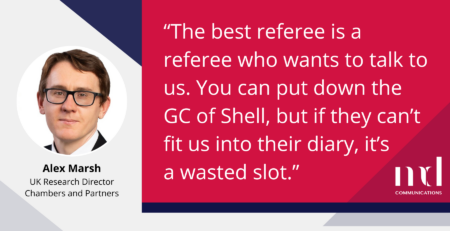Survey now live: Let us know your views on the legal directories
Next week we launch the research phase of our second white paper exploring how legal directories are adapting to and keeping pace with change and innovation in the legal sector. Have your say and be part of the debate.
Last year we launched our white paper ‘Legal Directories: are they still relevant?’ at the IBA conference in Sydney, gathering and analysing insights from over 200 participants globally across the legal sector.
In a nutshell, we asked the market if the directories still matter? Based on the findings of the paper, and the hundreds of requests for copies that we have received from around the world, the clear answer is yes. The conclusions were fascinating:
- 60% of GCs consulted the directories when appointing a law firm but in Europe and the US in particular, GCs use rankings to validate the use of known law firms.
- New challengers to the main directories face formidable obstacles, particularly if they want to expand beyond niche markets but were very much on the radar.
But there were clearly frustrations:
- GCs irked by a lack of information on fees, client service innovation such as use of AI and automation and alternative working models said that the directories were useful, but only up to a point.
- 84 per cent of law firms are frustrated with the time it takes to make a submission
- Buyers of legal services hinted at a preference for competing sources of information, more diverse than directory analysis, such as arenas where senior in-house lawyers share information.
Do these findings signal a desire for a change in focus and output from the directories? A year on, we want to find out more.
Legal directories and the rise and rise of innovation and client empowerment
Our second white paper will explore how legal directories are adapting to and keeping pace with change and innovation in the legal sector.
2018 has been a year of headlines for the directories so far. The Chambers & Partners buyout. The Legal 500 new online submission process. The rise in prominence of IFLR1000’s deal database and alternatives such as Top 3 Legal.
At the same time, the legal sector continues to see the impact of technology, driving improved client experiences and frankly, putting more pressure on lawyers to fight for their space in the crowded legal market.
Findings of Phase 1 of the IBA’s Future of Legal Services taskforce reported in 2017 that out of 41 drivers for change in the legal sector, ‘innovation’ ranked at number 7 and ‘client empowerment’ at number 1.
In the same year, Raconteur’s ‘Legal Innovation’ report made clear: ‘technology is revolutionising the legal sector. From artificial intelligence lowering costs, to blockchain providing data security, the industry is ripe for disruption’.
‘Product innovation’ once the realm of car to vacuum cleaner manufacturers, is now an established category on the legal awards circuit, (if you don’t believe us – see the FT European Lawyer Awards). ‘Product’ is a word that when I was a trainee, if it had been uttered in conjunction with legal services, like the word ‘sales’, would have sent senior partners into apoplexy, let alone mention ‘data and analytics’, ‘digital and emerging technologies’, ‘diversity and inclusion’.
Martin Šolc, president of the IBA summed up in the Raconteur report: “There has… been a huge change in how clients value legal services…. Many are looking at what legal work they can bring in, how they can better budget for and manage their legal service providers.”
Is enough prominence being given to alternative models from the wave of NewLaw providers, lean and niche start-ups with agile business models, to the big four?
In the future will buyers of legal services care which team ranks in band 1, based on a qualitative review by a directory and their peers? Or will they simply want to see quantitative data and analytics allowing them to quickly (without reading screeds of editorial) identify a team or individual with a track record of handling their type deal or case?
And where do ethics, diversity and gender pay gap data fit in? Are the metrics being employed by buyers of legal services changing and does this change the landscape for the traditional and new wave of directories?
In our second white paper, we will explore how the directories are keeping pace with these and other changes and influences in the legal sector and how they are innovating for the future.
We are asking for your contribution and considered insights. Are the legal directories keeping pace? Look out for and please complete our survey which will be published next week.












